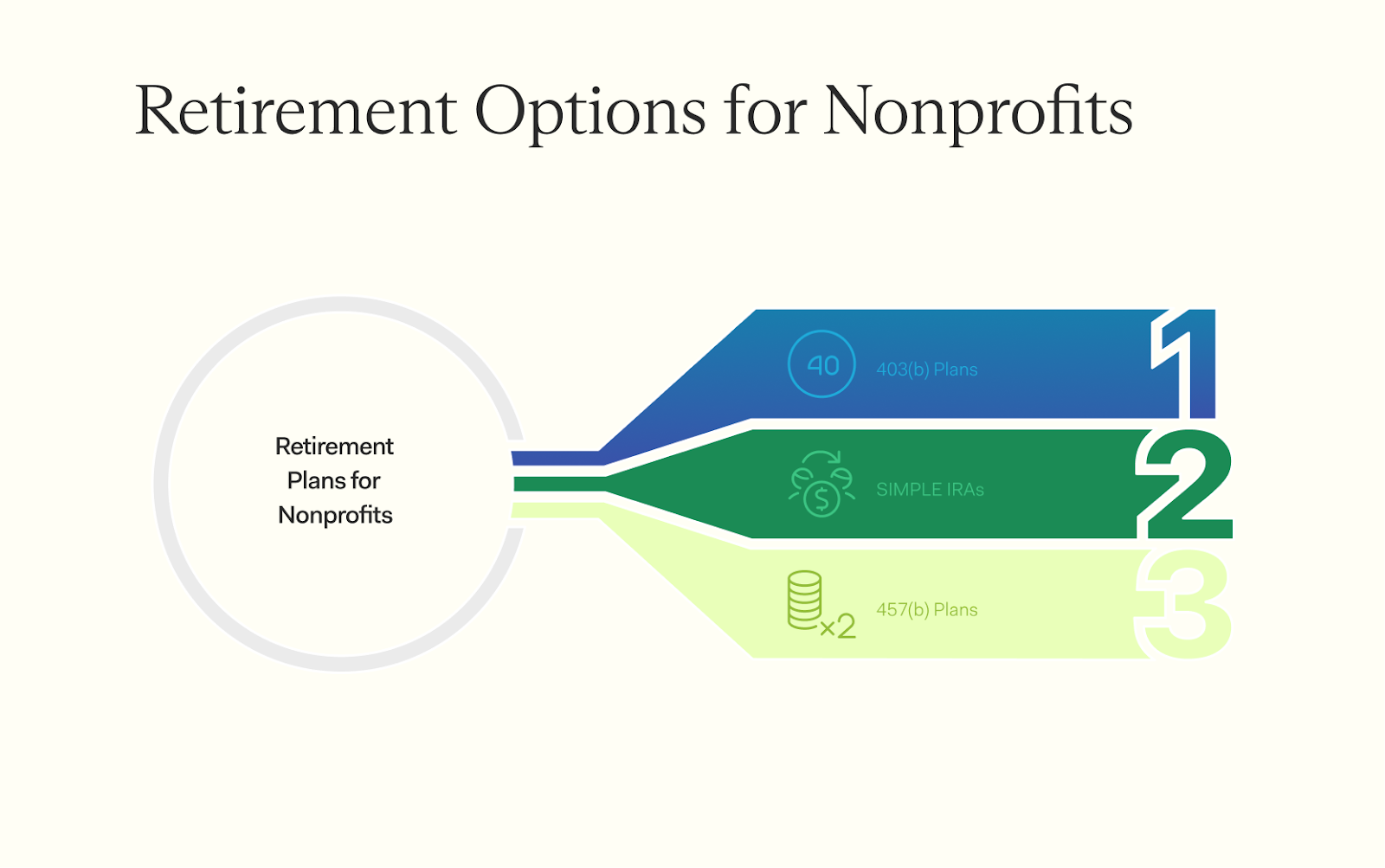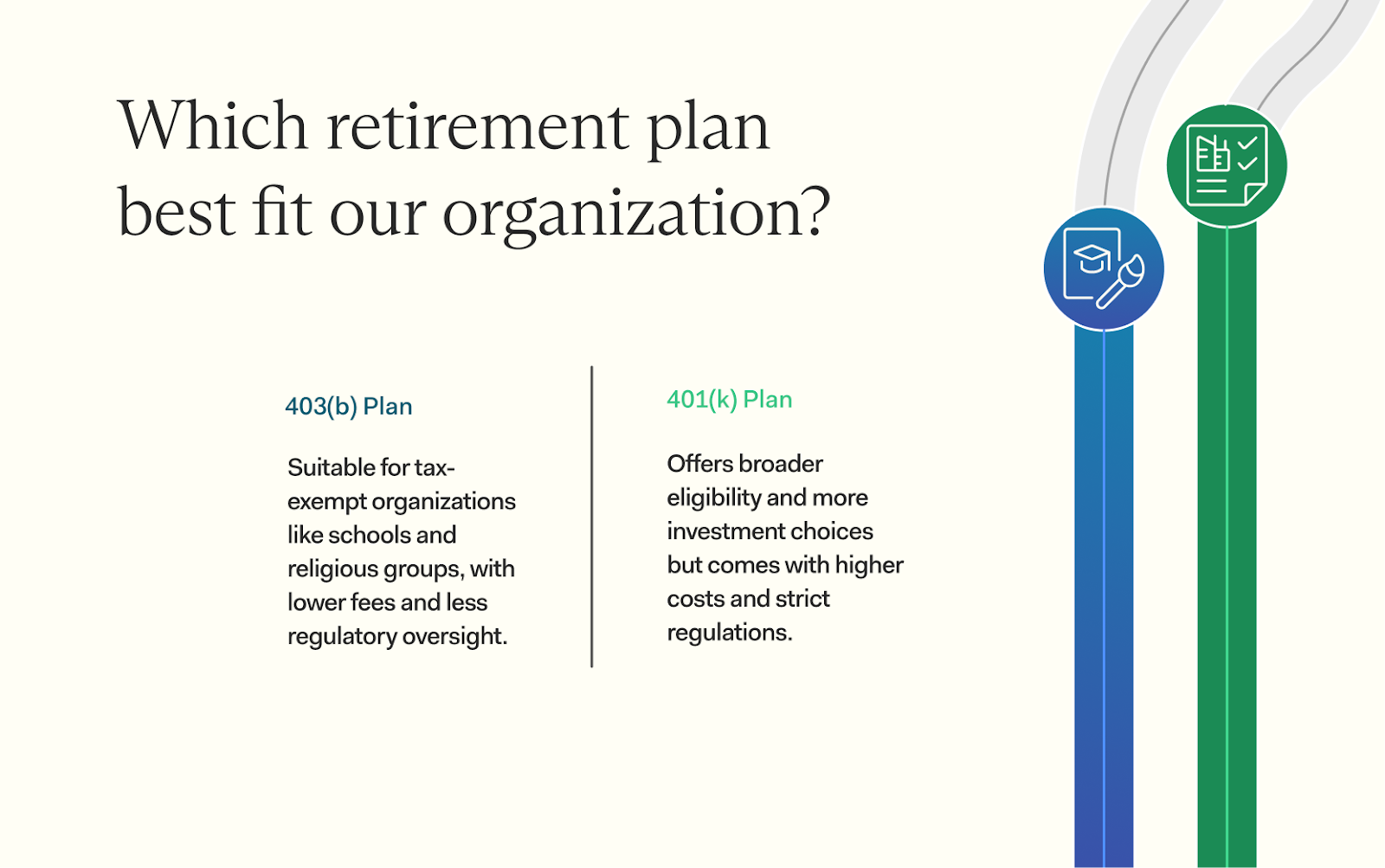Learn about the essentials of nonprofit 401(k) plans for employers. Understand regulations, benefits, and how to implement them effectively.
Selecting the right retirement plan for your nonprofit can feel overwhelming. Unlike private sector businesses, nonprofits have distinct options—and navigating them isn't always easy.
The good news? Nonprofits have access to several tailored retirement plans that can provide long-term security for employees while aligning with organizational goals. This guide will break down the best options, helping you choose a plan that benefits both your team and your mission.
Nonprofits can choose from several unique retirement plans, each with its own advantages. Think 403(b)s, SIMPLE IRAs, and 457(b) plans. These options help employees save effectively for their future.

These plans are designed for employees of tax-exempt organizations, like schools and hospitals. They allow employees to save for retirement while deferring taxes on the money until withdrawal.
These plans often include mutual funds and annuities as investment options. Schools, public hospitals, religious groups, and other nonprofit entities use them extensively. Employees can put part of their paycheck into these accounts before taxes.
This means they pay less income tax now.
A 403(b) plan helps employees in nonprofit sectors save for the future without feeling the pinch today.
The IRS sets limits on how much you can put into these accounts each year. For 2025, you can contribute up to $23,500 if you're under 50. If you're 50 or older, you get to add an extra $7,500 as a catch-up contribution.
Some plans also allow employer contributions which help grow your savings faster. Plus, if you've worked with the same nonprofit for many years, special rules might let you save even more.
SIMPLE IRAs are a great option for nonprofit organizations. They allow small employers to offer retirement plans to their employees without high costs. Employers with fewer than 100 employees can set up a SIMPLE IRA.
The plans let employees contribute through payroll deductions, which lowers their taxable income.
Employers must match employee contributions or make a fixed contribution each year. The annual contribution limit is $16,500 for 2025, plus an extra catch-up contribution of $3,500 for those aged 50 and older.
SIMPLE IRAs have less paperwork than other retirement accounts like 401(k) plans. This makes them easier to manage while still providing benefits to plan participants in tax-exempt organizations.
These plans present excellent options for tax-exempt organizations. They allow employees to save for retirement with pre-tax money. Contributions reduce taxable income, which can mean more take-home pay now.
Employees can also withdraw funds without penalties if they leave their job or face hardship.
Both government entities and certain nonprofit organizations can offer 457(b) Plans. They have distinct benefits, such as no annual contribution limits for catch-up contributions after age 50.
These plans assist employees in preparing well for retirement savings.
These two plan types serve different types of nonprofits, each with unique rules and benefits—check out the key differences to see which fits your organization better.

Employee qualifications for retirement plans can vary significantly. For 403(b) plans, employees usually need to work for a tax-exempt organization like public schools or religious organizations.
These workers must meet certain guidelines set by the employer.
In contrast, 401(k) plans have broader eligibility rules. Employees at most types of businesses and nonprofits can join these plans, including fewer employees at small firms. Simple IRAs have simpler standards too, making them easy to access for many workers seeking a retirement savings plan.
Each plan brings different rules based on factors like employee's compensation and service time. Understanding these differences helps nonprofit employers make better choices about which type of plan fits their needs best.
Tax advantages are key for nonprofit retirement plans. 403(b) and 401(k) plans allow employees to save money before taxes. This reduces their taxable income right away. Funds grow tax-free until withdrawal during retirement.
Certain contributions, like employer match and additional catch-up contributions, can boost savings too. Nonprofit employers can benefit from tax exemptions as well. These benefits help attract and keep staff while supporting long-term financial health for employees.
Nonprofits also enjoy flexibility in choosing the best plan options for their specific needs.
Each retirement plan has distinct administrative requirements. For 403(b) plans, the employer handles a lot of the paperwork. These plans often have lower fees and less regulatory oversight. This can be easier for nonprofits to manage.
On the other hand, 401(k) plans must follow strict government regulations under ERISA. This means more compliance testing and detailed reporting is required. Though they can offer more investment choices, they also come with higher costs for plan sponsors.
Choosing between these options depends on what fits your nonprofit best. Let's look at tips for choosing the right plan next.
The appropriate retirement plan helps your nonprofit attract and keep good workers. Make informed choices for a strong future.
Choosing the right retirement plan for your nonprofit is crucial to attracting and retaining top talent while ensuring long-term financial security for your employees. A Farther financial advisor can help you navigate options like 403(b) plans, SEP IRAs, and SIMPLE IRAs, ensuring compliance and maximizing benefits for both your organization and employees.
With expert guidance, you can create a retirement plan that aligns with your nonprofit's mission and financial goals. Support your team's future—talk to an advisor today.
Retirement plans for nonprofits are essential for securing your employees' financial future. Options like 403(b), SIMPLE IRAs, and 457(b) plans each offer unique benefits tailored to nonprofit organizations.
Selecting the right plan isn't just a short-term decision—it's an investment in long-term stability for your team and your mission. By making the right choice today, you're helping build a stronger, more secure future for everyone.
Nonprofit employers have a wide array of retirement plans to choose from. This includes 401(k) and 403(b) plans, traditional individual retirement accounts (IRA), pension plans, cash balance plans, and annuity plans.
401(k) and 403(b) are defined contribution plans that offer tax advantages to employees of certain tax-exempt organizations. Annuity options like the 403(b) tax-sheltered annuity plan or other annuity offerings provide regular income during retirement. Pension and cash balance schemes are employer-sponsored retirement systems where benefits accumulate over time.
A nonprofit 401(k) is specifically designed for tax exempt organizations such as health sciences institutions or self-employed individuals within nonprofits. It offers catch up contributions for employees younger than the standard age limit, providing an additional benefit not always found in other types of employer-sponsored retirements.
Employee Retirement Income Security Act (ERISA) governs many aspects of employer-sponsored retirements but some offerings such as certain non-profit sector schemes may be considered Non-ERISA Plans if they meet specific criteria outlined by Internal Revenue Service regulations.
Yes indeed! From an administrative perspective, factors like nondiscrimination testing under ACP test rules, handling potential plan failures or ensuring universal availability can impact the decision on type of plan offered by nonprofits.
The Plan Sponsor Council Of America provides valuable insights into various aspects including safe harbor provisions and legal requirements while the National Council of Nonprofits provides insights on employee benefits specific to the nonprofit sector.